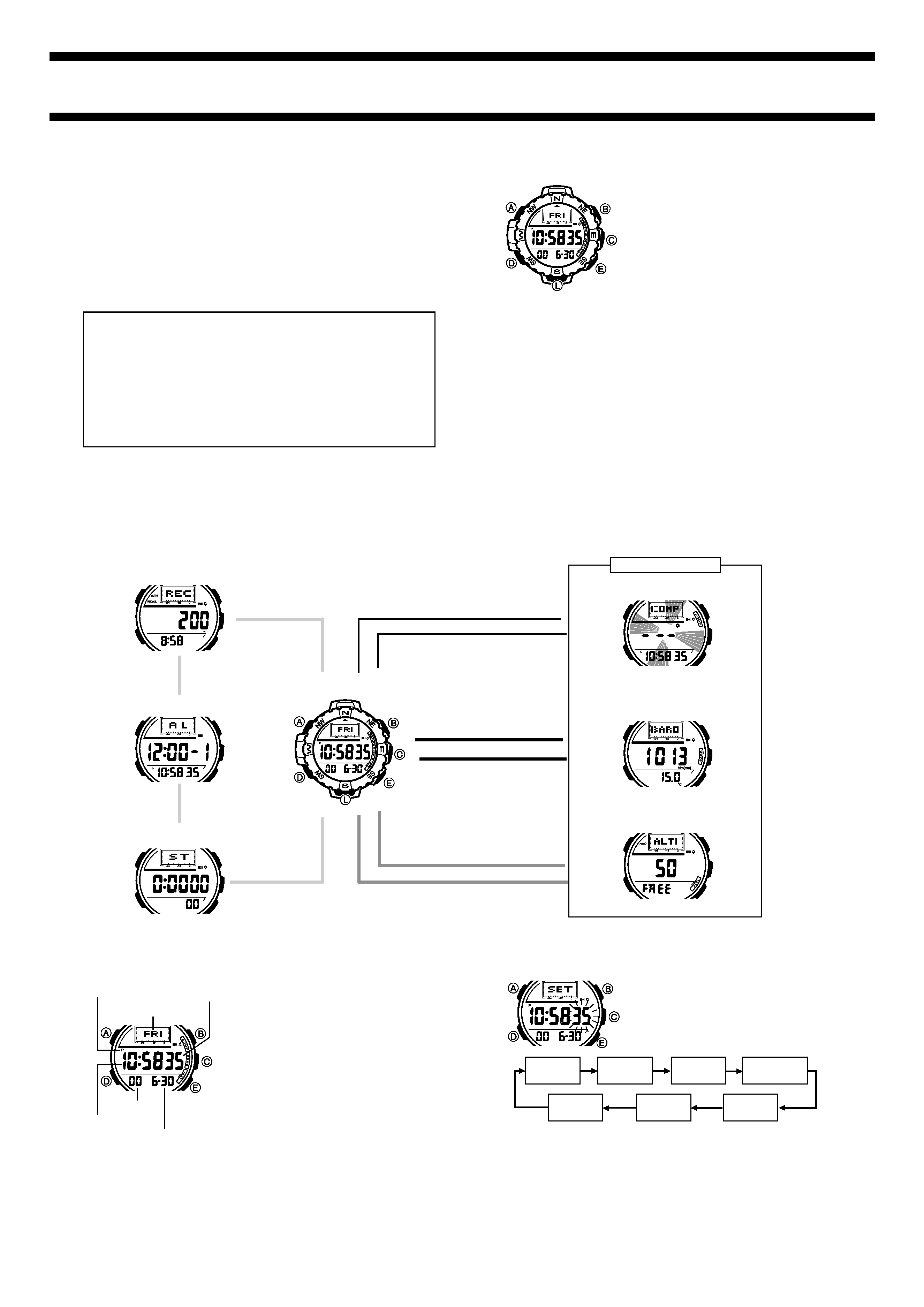
2271-1
Module No. 2271
GETTING ACQUAINTED
Congratulations upon your selection of this CASIO watch. To get the most out
of your purchase, be sure to carefully read this manual and keep it on hand
for later reference when necessary.
Applications
The built-in sensors of this watch measure direction, altitude, barometric
pressure, and temperature. Measured values are then shown on the display.
Such features make this watch useful when hiking, mountain climbing, or
when engaging in other such outdoor activities.
Warning!
· The measurement functions built into this watch are not intended for
taking measurements that require professional or industrial precision.
Values produced by this watch should be considered as reasonable
representations only.
· When engaging in mountain climbing or other activities in which losing
your way can create a dangerous or life-threatening situation, always
be sure to use a second compass to confirm direction readings.
· CASIO COMPUTER CO., LTD. assumes no responsibility for any loss,
or any claims by third parties that may arise through the use of this
watch.
(Light)
About This Manual
· Button operations are indicated using the
letters shown in the illustration.
· Each section of this manual provides you
with the information you need to perform
operations in each mode. Further details
and technical information can be found in
the "REFERENCE" section.
GENERAL GUIDE
· If the digital display of your watch is continuously changing, see
"Auto Display Function" for information on how to stop it.
· The illustration below shows which buttons you need to press to navigate
between modes.
· In any mode, hold down D for about one second to return to the
Timekeeping Mode.
· You can use buttons B, C, and E to directly enter a sensor mode from
the Timekeeping Mode or from another sensor mode. To get to a sensor
mode from the Recall, Alarm, or Stopwatch Mode, you must go to the
Timekeeping Mode first.
Press D.
Recall Mode
Stopwatch Mode
Alarm Mode
Sensor Modes
Altimeter Mode
Digital Compass Mode
Barometer/
Thermometer Mode
Timekeeping Mode
L
L
D
D
L
L
L
L
L
L
L
L
Press B.
D
C
D
E
DD
TIMEKEEPING
Use the Timekeeping Mode to set and view
the current time and date.
To reset the seconds count to zero
1. In the Timekeeping Mode, hold down A
until the second digits start to flash, which
indicates the setting screen.
2. Press E to reset the seconds count to 00.
· Pressing E while the seconds count is
in the range of 30 to 59 resets the
seconds to 00 and adds 1 to the
minutes. In the range of 00 to 29, the
minutes count is unchanged.
3. Press A to exit the setting screen.
Hour : Minutes
PM indicator
Seconds
Month Day
Day of week
Year
To set the time and date
1. In the Timekeeping Mode, hold down A
until the second digits start to flash, which
indicates the setting screen.
2. Press D to move the flashing in the
sequence shown below to select other
settings.
Seconds
Hour
Minutes
Day
Month
Year
12/24-Hour
Format
3. While a setting is flashing, use E (+) and B () to change it.
· When the 12/24-hour setting is selected, press E or B to toggle
between 12-hour (12H) and 24-hour (24H) timekeeping.
4. Press A to exit the setting screen.
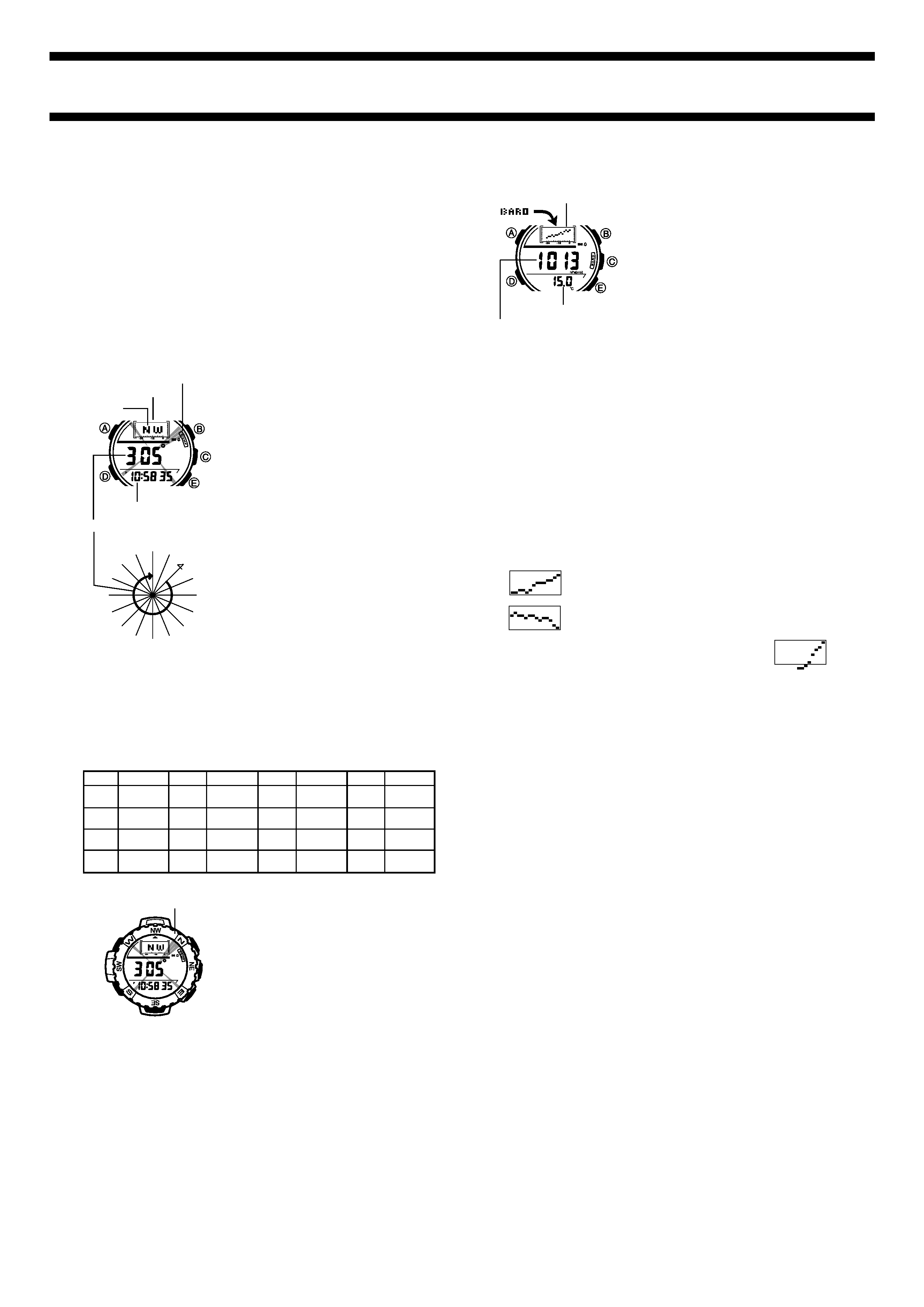
2271-2
DIGITAL COMPASS
A built-in bearing sensor detects magnetic north and indicates one of 16
directions on the display. Direction readings are performed in the Digital
Compass Mode.
· You can calibrate the bearing sensor if you suspect the direction reading is
incorrect.
To enter and exit the Digital Compass Mode
1. While in the Timekeeping, Barometer/Thermometer, or Altimeter Mode,
press B to enter the Digital Compass Mode.
· At this time, the watch immediately starts a Digital Compass operation.
After about two seconds, letters appear on the display to indicate the
direction that the 12 o'clock position of the watch is pointing.
2. Press D to return to the Timekeeping Mode.
To take a direction reading
1. Enter the Digital Compass Mode.
2. Place the watch on a flat surface or (if you
are wearing the watch), make sure that
your wrist is horizontal (in relation to the
horizon).
3. Point the 12 o'clock position of the watch in
the direction you want to measure.
4. Press B to start a Digital Compass
measurement operation.
· After about two seconds, the direction
that the 12 o'clock position of the watch
is pointing appears on the display.
· Also, four pointers appear to indicate
magnetic north, south, east, and west.
· After the first reading is obtained, the
watch continues to take direction
readings automatically each second, for
up to 30 seconds.
· The COMP indicator flashes on the
display while a measurement is in
progress.
· The direction value that appears on the
display represents the clockwise angle
formed between magnetic north (which
is 0 degrees) and the displayed
direction.
Direction
Direction value (in degrees)
Timekeeping Mode time
Magnetic north pointer
12 o'clock position
NW
0
°
WN
W
W
WSW
SW
S
S
W
S
SS
E
SE
ESE
E
E
N
E
NE
N
N
E
N
NNW
Note
· Note that taking a measurement while the watch is not horizontal (in
relation to the horizon) can result in large measurement error.
· Pressing B while in the Digital Compass Mode starts a new direction
measurement operation.
· The following table shows the meanings of each of the direction
abbreviations that appear on the display.
· You can adjust the rotary direction bezel so
that the "N" is aligned with the magnetic
north pointer. This correctly aligns all of the
markings on the bezel.
· The Digital Compass operation is
automatically interrupted whenever an
alarm (Daily Alarm or Hourly Time Signal)
sounds. If this happens, start the Digital
Compass operation again from the
beginning.
· See "Digital Compass Precautions" for other
important information about taking direction
readings.
Direction Meaning
Direction
Meaning
Direction
Meaning
Direction
Meaning
Direction bezel
NNE
ESE
SSW
WNW
NE
SE
SW
NW
North-
northeast
East-
southeast
South-
southwest
West-
northwest
Northeast
Southeast
Southwest
Northwest
East-
northeast
South-
southeast
West-
southwest
North-
northwest
ENE
SSE
WSW
NNW
North
East
South
West
N
E
S
W
BAROMETER/THERMOMETER
This watch uses a pressure sensor to measure air pressure (barometric
pressure) and a temperature sensor to measure a temperature.
· You can calibrate the temperature sensor and the pressure sensor if you
suspect that readings are incorrect.
Barometric pressure graph
(unit: 1hPa (mb)/0.05 inHg)
Temperature
Barometric pressure
A rising graph generally means improving weather.
A falling graph generally means deteriorating weather.
Note that if there are sudden changes in weather or
temperature, the graph line of past measurements may run
off the top or bottom of the display. The entire graph will
become visible once barometric conditions stabilize.
The following conditions cause the barometric pressure
measurement to be skipped, with the corresponding point on
the barometric pressure graph being left blank.
· Barometric reading that is out of range (260 hPa/mb to 1100 hPa/mb or
7.65 inHg to 32.45 inHg)
· Sensor malfunction
· Dead batteries
About Barometric and Temperature Measurements
· Barometric pressure and temperature measurement operations are
performed as soon as you enter the Barometer/Thermometer Mode. After
that, temperature measurements are taken every five seconds for the first
three minutes, and then taken every five minutes thereafter.
· The BARO indicator flashes on the display while a measurement is in
progress.
· The barometer automatically takes measurements every two hours
(starting from midnight), regardless of what mode you are in. The results of
these measurements are used for the barometric pressure graph.
· You can also perform a barometric pressure and temperature
measurement at any time by pressing C in the Barometer/Thermometer
Mode.
Barometer and Thermometer Precautions
· The pressure sensor built into this watch measures changes in air
pressure, which you can then apply to your own weather predictions. It is
not intended for use as a precision instrument in official weather prediction
or reporting applications.
· Sudden temperature changes can affect pressure sensor readings.
· Temperature measurements are affected by your body temperature (while
you are wearing the watch), direct sunlight, and moisture. To achieve a
more accurate temperature measurement, remove the watch from your
wrist, place it in a well ventilated location out of direct sunlight, and wipe off
all moisture from the case. It takes approximately 20 to 30 minutes for the
case of the watch to reach the actual surrounding temperature.
· You can change the measured barometric pressure unit between hecto-
pascals/millibars (hPa/mb) and inchesHg (inHg). See "Changing the
Barometric Pressure and Temperature Units" for details.
· You can change the measured temperature value displayed by this watch
between Celsius (
°C) and Fahrenheit (°F). See "Changing the Barometric
Pressure and Temperature Units".
Not visible on
the display.
Understanding the Barometer/Thermometer Screen
Press C to enter the Barometer/Thermometer
Mode.
· Barometric pressure is displayed in units of
1hPa/mb (or 0.05inHg).
· Temperature is displayed in units of 0.1°C
(or 0.2
°F).
· The displayed barometric pressure value
changes to xxxx hPa/mb (or inHg) if a
measured barometric pressure falls outside
the range of 260 hPa/mb to 1100 hPa/mb
(7.65 inHg to 32.45 inHg). The barometric
pressure value will be displayed again as
soon as the measured barometric pressure
is within the allowable range.
· The displayed temperature value changes to xx. x °C (or °F) if a
measured temperature falls outside the range of 10.0
°C to 60.0°C (14.0°F
to 140.0
°F). The temperature value will be displayed again as soon as the
measured temperature is within the allowable range.
· Some countries refer to the barometric pressure unit hecto-pascal (hPa) as
millibars (mb). It really makes no difference, because 1hPa = 1mb. In this
manual, we use hPa/mb or hPa (mb).
Barometric Pressure Graph
Barometric pressure indicates changes in the atmosphere. By monitoring
these changes you can predict the weather with reasonable accuracy. The
barometric pressure graph shows the barometric readings for the past 26
hours. The flashing point on the right of the display is the point for the newest
measurement. Note that pressure graph readings are relative to the newest
measurement point. One dot above the newest point is plus 1hPa(mb)/
0.05inHg, while one dot below is minus 1hPa(mb)/0.05inHg. The following
shows how to interpret the data that appears on the barometric pressure
graph.
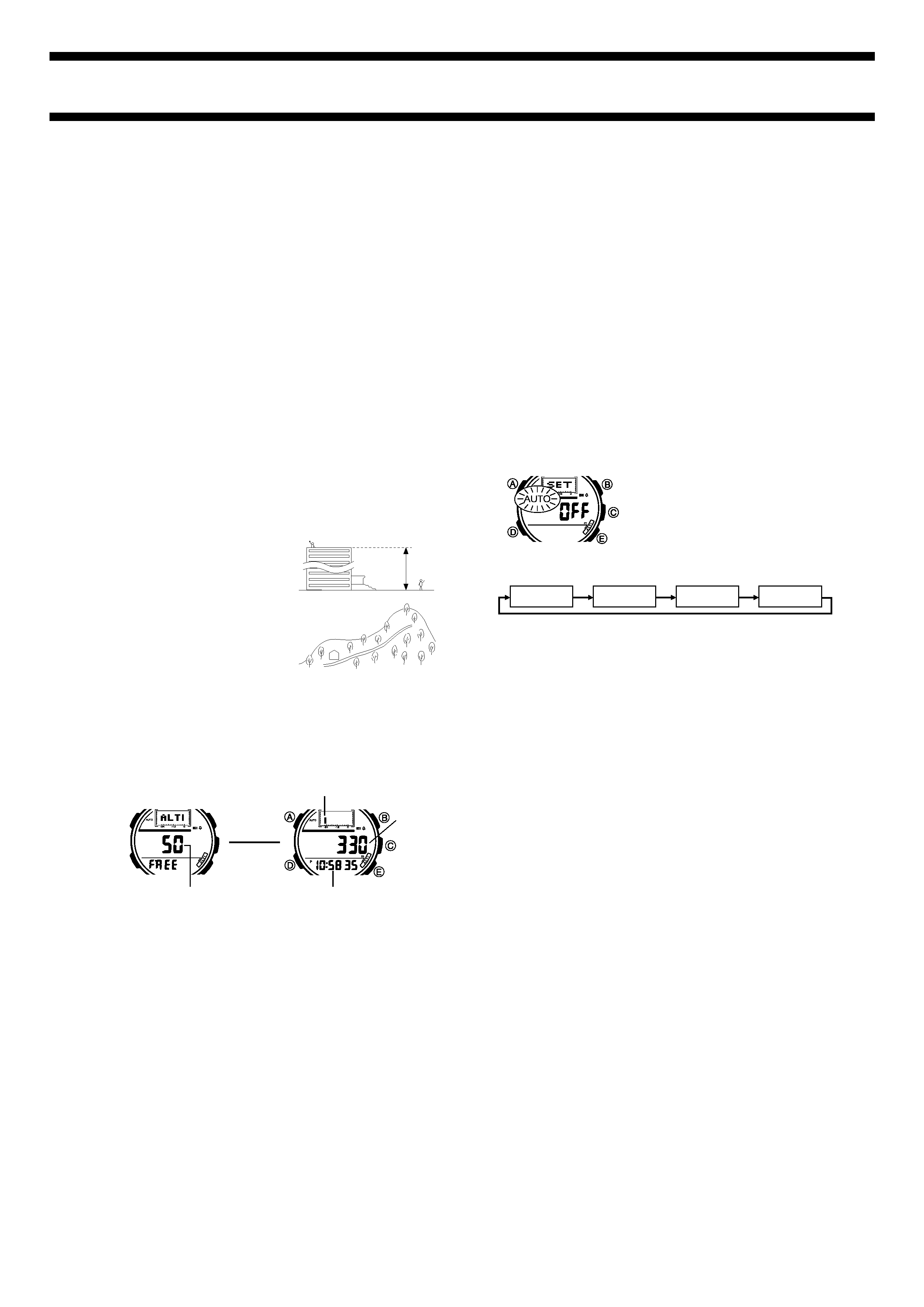
2271-3
ALTIMETER
A built-in altimeter uses a pressure sensor to detect the current air pressure,
which is then used to estimate the current altitude. The watch is pre-
programmed with ISA (International Standard Atmosphere) preset values,
which are used to convert air pressure readings to altitude values. If you
preset a reference altitude, the watch will also calculate the current relative
altitude based on your preset value. Altimeter functions also include data
storage memory and an altitude alarm.
Important!
· This watch estimates altitude based on air pressure. This means that
altitude readings for the same location may vary if air pressure changes.
· This watch employs a semiconductor pressure sensor, which is affected by
temperature changes. When taking altitude measurements, be sure to do
so while ensuring that the watch is not exposed to temperature changes.
· Do not rely upon this watch for altitude measurements or perform button
operations while engaging in sports where there are sudden altitude
changes, while sky diving, hang gliding, or paragliding, or while riding a
gyrocopter, glider, or any other aircraft.
· Do not use this watch for measuring altitude in applications that demand
professional or industrial level precision.
How the Altimeter Works
With the Preset Values (No Reference Altitude)
· The watch measures the air pressure at your current location and uses the
built-in ISA values to convert it to the equivalent altitude.
With a Reference Altitude
· After you set the reference altitude, the watch adjusts its air pressure to
altitude conversion calculation accordingly.
· To determine the height of a tall building,
set the reference altitude to 0 on the
ground floor. Note, however, that you may
not be able to get a good reading if the
building is pressurized or air-conditioned.
· When mountain climbing, you can set the
reference value in accordance with a
marker along the way or altitude
information from a map. After you do this,
the altitude readings produced by the
watch will be more accurate than they
would without a reference altitude.
· Note that the following conditions will
prevent you from obtaining accurate readings:
When air pressure changes because of changes in the weather
Extreme temperature changes
When the watch itself is subjected to strong impact
Understanding the Altimeter Screen
Press E to enter the Altimeter Mode.
· Altitude is displayed in units of 5 meters (20 feet).
· The measurement range for altitude is 700 to 10,000 meters (2,300 to
32,800 feet).
· The measured altitude may be a negative value in cases where there is a
reference altitude value set or because of certain atmospheric conditions.
· The displayed altitude value changes to xxxx meters (or feet) if a
measured altitude falls outside the measurement range. The altitude value
will be displayed again as soon as the measured altitude is within the
allowable range.
· You can change the unit of measurement for the displayed altitude values
between meters (m) and feet (ft). See "To change the Altitude Units".
About Altitude Measurements
There are two types of altitude measurements: those for displayed data
(Altimeter Mode measurements) and those for memory data (Memory
measurements).
Altimeter Mode measurement
This type of measurement is performed only when the watch is in the
Altimeter Mode. As soon as you enter the Altimeter Mode, measurements are
taken every five seconds for the first three minutes. After that, measurements
are taken every two minutes.
· The ALTI indicator flashes on the display while a measurement is in progress.
400
A
B
Remaining memory
1 second later
Altitude graph (current altitude flashing) (unit: 10m/40 ft.)
Altitude
Timekeeping Mode time
L
Memory measurements
Memory measurements are taken independently of Altimeter Mode
measurements and stored directly into memory (along with the date and time
of the measurement) for later recall. There are two types of memory
measurements: "Auto measurements" and "Manual measurements".
Auto measurements
With Auto measurement, the watch continuously performs measurements
whenever the minutes in the Timekeeping Mode reach 00, 15, 30, or 45, until
you switch Auto measurements off. The watch continues to take
measurements regardless of whether or not you change modes, so you can
keep a running log of altitude changes automatically.
Manual measurements
You can use the manual procedure to take a reading anytime you want to
store your current altitude data into memory for later recall. Manual memory
measurements can be performed only while the watch is in the Altimeter
Mode.
Selecting Auto or Manual Measurement
Use the following procedure to switch between Auto or Manual measurement.
Note that you cannot perform this operation while a preset Auto measurement
is already in progress.
To select Auto or Manual measurement
1. In the Altimeter Mode, hold down A until
the display clears. After four or five
seconds, either OFF or the current
reference altitude value (if set) will start to
flash, which indicates the setting screen.
2. Press D twice to move the flashing to the
memory measurement setting (AUTO or
MANUAL).
· Press D to move the flashing in the sequence shown below.
Reference
Altitude
Altitude
Alarm
Memory
Measurement
Altitude
Unit
3. While the memory measurement setting is flashing, press B or E to
select AUTO (Auto measurement) or MANUAL (Manual measurement).
4. Press A to exit the setting screen.
· An indicator on the display shows the type of measurement (AUTO or
MANUAL) that you currently have selected.
To use Auto measurement
1. Confirm that the AUTO indicator is shown on the display.
· If it is not, use the procedure under "To select Auto or Manual
measurement" to select Auto measurement.
2. In the Altimeter Mode, hold down E until the watch emits a short beep,
indicating the start of the measurement.
3. To stop measurements at any point in the Altimeter Mode, hold down E
again until the watch emits a short beep.
· The data that is measured when you first start Auto measurement is
also stored into memory.
· The AUTO indicator flashes on the display when you start Auto
measurements. The AUTO indicator continues to flash (indicating that
measurements continue) even if you change modes.
· Auto measurement cuts off automatically whenever there are 49
records stored in memory. The 50th record measurement when you
stop measurement in step 3 above is also stored in memory.
· A final measurement is taken when you turn off Auto measurement,
and that data is also stored into memory. Such data is indicated by
FIN during the recall operation.
To use Manual measurement
1. Confirm that the MANUAL indicator is shown on the display.
· If it is not, use the procedure under "To select Auto or Manual
measurement" to select Manual measurement.
2. In the Altimeter Mode, hold down E until the watch emits a short beep,
indicating that a measurement is taken.
· Repeat step 2 whenever you want to take a reading.
· Button operation becomes impossible during the four or five seconds
that it takes to complete a measurement. Normal operation will return
once the operation is finished.
Setting a Reference Altitude
After you set a reference altitude, the watch adjusts its air-pressure-to-altitude
conversion calculation accordingly. The altitude measurements produced by
this watch are subject to error caused by changes in air pressure. Because of
this, we recommend that you update the reference altitude whenever one is
available during your climb.
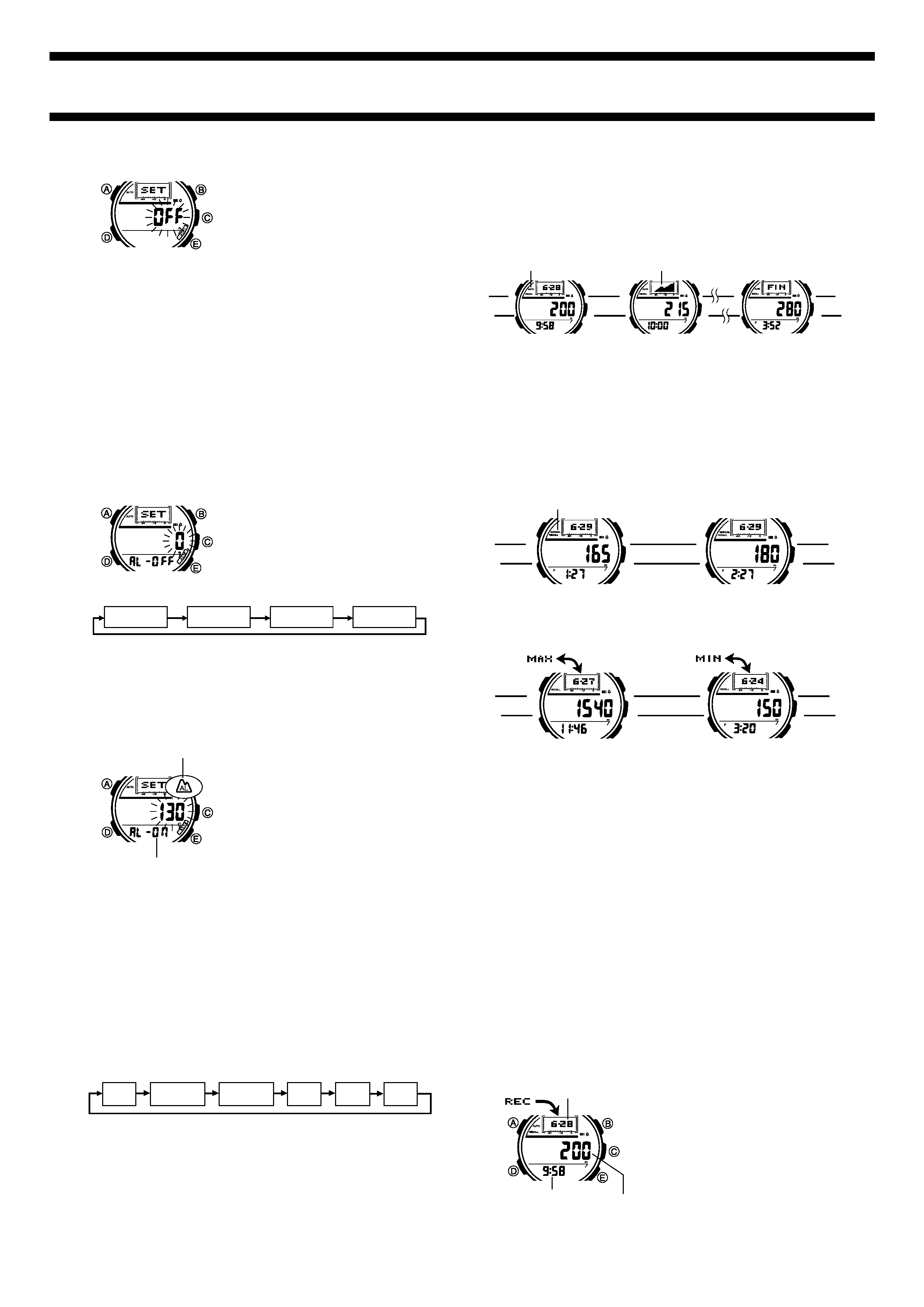
2271-4
To set a reference altitude
1. In the Altimeter Mode, hold down A until
the display clears. After four or five
seconds, either OFF or the current
reference altitude value (if set) will start to
flash, which indicates the setting screen.
· OFF indicates no reference altitude.
2. Press E to increase the current reference
altitude value by 5 meters (or 20 feet) or B
to decrease it.
· You can set the reference altitude within the range of 10,000 to 10,000
meters (32,800 to 32,800 feet).
· Pressing E and B at the same returns to OFF, so the watch
performs air pressure to altitude conversions based on preset data
only.
3. Press A to exit the setting screen.
About the Altitude Alarm
The altitude alarm sounds for about five seconds whenever the current
altitude matches a preset value. You can press any button to stop the alarm
after it starts to sound.
Example
If you set the altitude alarm at 130 meters, it sounds when you pass the 130-
meter mark on your way up and on your way back down.
To set the altitude alarm
1. In the Altimeter Mode, hold down A until
the display clears. After four or five
seconds, either OFF or the current
reference altitude value (if set) will start to
flash, which indicates the setting screen.
2. Press D once to move the flashing to the
altitude alarm setting.
· Press D to move the flashing in the
sequence shown below.
Reference
Altitude
Altitude
Alarm
Memory
Measurement
Altitude
Unit
3. While the altitude alarm setting is flashing, press E to increase the
current altitude alarm value by 5 meters (or 20 feet) or B to decrease it.
· You can set the altitude alarm value within the range of 10,000 to
10,000 meters (32,800 to 32,800 feet).
· Pressing E and B at the same resets the altitude alarm value to O.
4. Press A to exit the setting screen.
To turn the altitude alarm on and off
1. In the Altimeter Mode, hold down A until
the display clears. After four or five
seconds, either OFF or the current
reference altitude value (if set) will start to
flash, which indicates the setting screen.
2. Press D once to move the flashing to the
altitude alarm setting.
3. Press C to switch the altitude alarm on
(ON) and off (OFF).
4. Press A to exit the setting screen.
· If the altitude alarm is on, the altitude
alarm on indicator remains on the
display when you change to another
mode.
Memory Data Management
Each altitude record includes an altitude reading, plus the month, day, hour,
and minutes the measurement was taken. Records are displayed in the order
they were saved.
Memory can hold up 50 records. You can store 50 Auto measurement
records, 50 Manual measurement records, or any mixed combination of Auto
and Manual measurement records. In addition, there are two extra records
that show the highest (max) and lowest (min) altitude values, from among the
displayed data (Altimeter Mode measurements) and memory data (Memory
measurements).
The following example illustrates how data would be arranged in memory after
you perform one Auto measurement (Auto 1), two Manual measurements
(Manual 1, Manual 2), and then one Auto measurement (Auto 2).
Auto 1
Auto 2
MAX
MIN
Manual 2
Manual 1
· Note that the highest (MAX) and lowest (MIN) records always are last.
Altitude alarm on indicator
Current On/Off status
Auto Measurement Records
· Performing an Auto measurement produces a set of records of all the
measurements taken during the Auto measurement session. Since Auto
measurement produces four altitude readings per hour (at 00, 15, 30, and
45 minutes of each hour) leaving Auto measurement turned on for two
hours would result in a set of eight records.
· The following shows how the records that make up an Auto measurement
set appear when you recall them.
· The altitude graph separates the maximum and minimum altitude readings
by nine display dots. Other readings are shown relative to the maximum
and minimum.
· Note that Auto measurement records are always treated as a set. This
means that deleting one record in a set deletes the entire set.
Manual Measurement Records
· Performing a Manual measurement produces a single record. The
illustration below shows how a Manual measurement record appears when
you recall it.
MIN and MAX Records
· The MIN record shows the lowest altitude reading from among those
contained in memory (both Auto and Manual), and the reading displayed in
Altimeter Mode. The
MAX record shows the highest altitude reading.
· When you display the MAX screen, the message MAX alternates every
second with the date in the upper display. The message
MIN alternates
on the
MIN screen.
· The MIN and MAX records are changed automatically whenever a
measurement produces a reading that is greater than the current
MAX
value or less than the current
MIN value.
Note
· 50 records are enough to store 12 hours and 15 minutes of Auto
measurement data (if you do not take any Manual readings during that
time).
Important!
· Further Auto or Manual measurements become impossible whenever
memory is full. The message FULL on the display indicates that memory
is full. Always check the amount of memory remaining before starting
memory measurements, and delete records if necessary.
L
L
L
L
L
L
L
L
AUTO indicator
Altitude graph
First record
of the set
All records between the initial
screen and final screen
Final record
of the set
MANUAL indicator
L
L
L
L
L
L
L
L
L
L
L
L
Highest Altitude Attained
Lowest Altitude Attained
Recalling Altitude Measurement Records
Use the Recall Mode to recall altitude measurement records. You can enter
the Recall Mode by pressing the D button.
· Measurement records are stored in memory even if an error occurs during
the measurement. For details on errors, see "Warning Indicators".
To recall altitude measurement records
In the Recall Mode, press E to scroll forward
through the stored records or B to scroll
backward.
· See "Memory Data Management" for
information about how data is stored.
Date
Time
Altitude
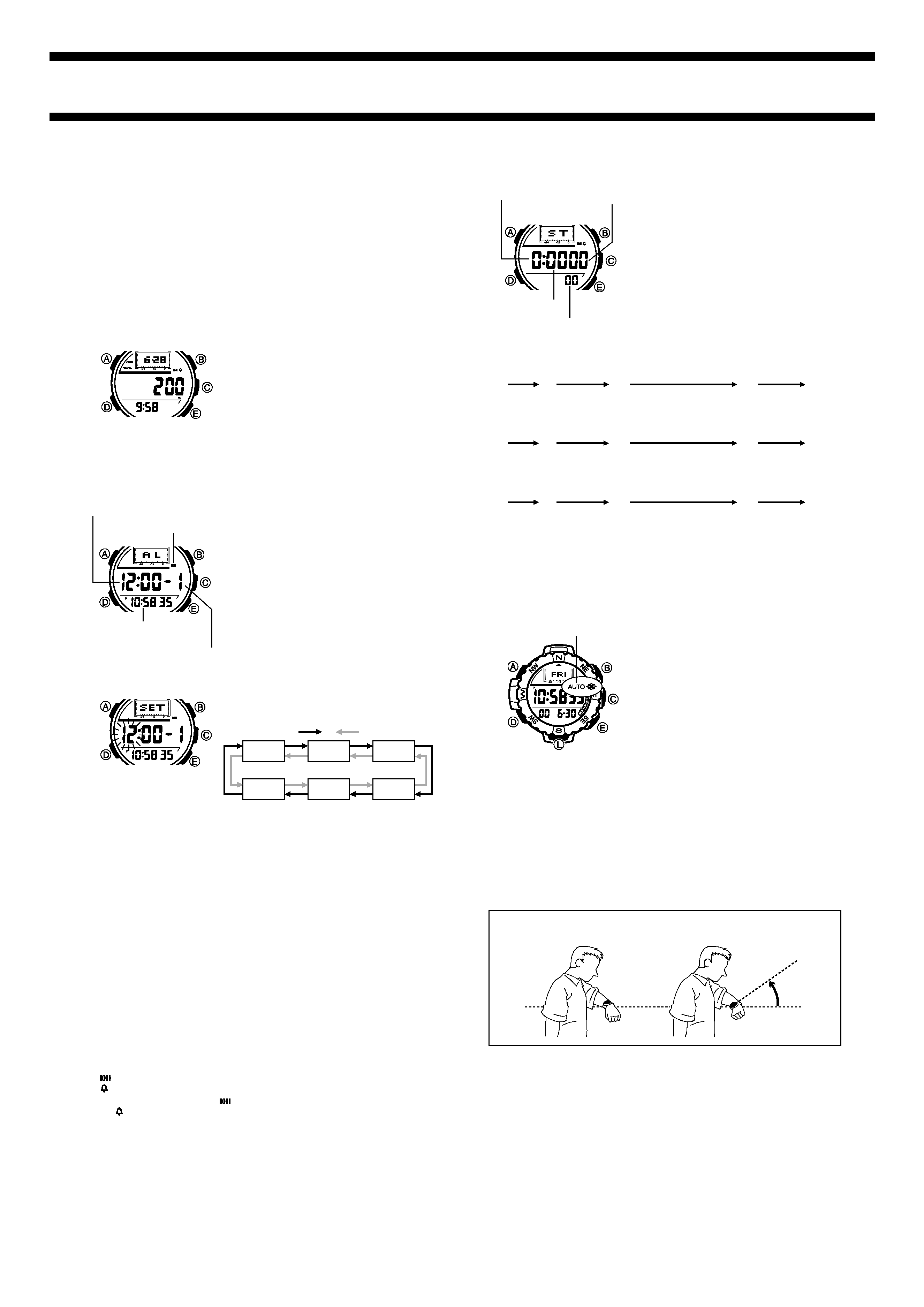
2271-5
Deleting an Altitude Measurement Record
Use the Recall Mode to delete altitude measurement records. You can enter
the Recall Mode by pressing D.
Note
· The procedure you should use to delete a record depends on if the record
was produced by Auto measurement or Manual measurement.
· Deleting Auto measurement records deletes the entire set, from the initial
record to the final record.
· You cannot delete a record that is part of an ongoing Auto measurement
operation (indicated when AUTO is flashing on the display). You can,
however, delete records from another, already completed measurement
operation.
To delete a altitude measurement record
1. In the Recall Mode, display the record you
want to delete.
· If you want to delete a set of Auto
measurement records, display the first
record of the set.
2. To clear the data, hold down A until the
watch emits a long beep (and until
CLR
stops flashing on the display).
First record of the set
ALARM
You can set five independent Daily Alarms.
When an alarm is turned on, the alarm tone
sounds when the alarm time is reached. You
can also turn on an Hourly Time Signal that
causes the watch to beep twice every hour on
the hour.
· The alarm number (1 through 5) indicates
an alarm screen.
SIG appears in place of
AL when the Hourly Time Signal screen is
shown.
· All of the operations in this section are
performed in the Alarm Mode, which you
enter by pressing D.
To set an alarm time
1. In the Alarm Mode, use E and B to
select the alarm whose time you want to
set.
2. Hold down A until the hour digits of the alarm time start to flash, which
indicates the setting screen.
· This automatically turns on the alarm.
3. Press D to move the flashing between the hour and minutes.
4. While a setting is flashing, use E (+) and B () to change it.
· When setting the alarm time using the 12-hour format, take care to set
the time correctly as a.m. (no indicator) or p.m. (P indicator).
5. Press A to exit the setting screen.
Alarm Time (Hour : Minutes)
Alarm on indicator
Timekeeping Mode time
Alarm number
AL-1
SIG
AL-2
AL-5
AL-3
AL-4
Press E.
Press B.
Alarm Operation
The alarm sounds at the preset time for about 20 seconds (in all modes), or
until you stop it by pressing any button.
To test the alarm
In the Alarm Mode, hold down C to sound the alarm.
To turn an alarm and the Hourly Time Signal on and off
1. In the Alarm Mode, use E and B to select an alarm or the Hourly Time
Signal.
2. When the alarm or the Hourly Time Signal you want to is selected, press
C to turn it on and off.
Indicates alarm is ON.
Indicates Hourly Time Signal is ON.
· The alarm on indicator (
) and the Hourly Time Signal on indicator
(
) are shown on the display in all modes while these functions are
turned on.
· If any alarm is on, the alarm on indicator is shown on the display in all
modes.
Start
Stop
Re-start
Stop
Clear
Split release
Start
Split
Stop
Clear
Start
Split
First runner
finishes.
Stop
Second runner finishes.
Record time of first
runner.
Split release
Record time of
second runner.
Clear
EE
E
E
B
EB
B
E
B
EB
E
B
B
STOPWATCH
The stopwatch lets you measure elapsed time,
split times, and two finishes.
· The display range of the stopwatch is 23
hours, 59 minutes, 59.99 seconds.
· The stopwatch continues to run, restarting
from zero after it reaches its limit, until you
stop it.
· The stopwatch measurement operation
continues even if you exit the Stopwatch
Mode.
· All of the operations in this section are
performed in the Stopwatch Mode, which
you enter by pressing D.
To measure times with the stopwatch
Elapsed Time
Split Time
Two Finishes
Hours
Minutes
1/100 second
Seconds
BACKLIGHT
The backlight uses an EL (electro-
luminescent) panel that causes the entire
display to glow for easy reading in the dark.
The watch's auto light switch automatically
turns on the backlight when you angle the
watch towards your face.
· The auto light switch must be turned on
(indicated by the auto light switch on
indicator) for it to operate.
· See "Backlight Precautions" for other
important information about using the
backlight.
To turn on the backlight manually
In any mode, press L to illuminate the display for about one second.
· The above operation turns on the backlight regardless of the current auto
light switch setting.
About the Auto Light Switch
Turning on the auto light switch causes the backlight to turn on for about one
second, whenever you position your wrist as described below in any mode.
· Be sure to wear the watch on the outside of your left wrist while using the
auto light switch.
Moving the watch to a position that is parallel to the ground and then tilting
it towards you more than 40 degrees causes the backlight to turn on.
Warning!
· Always make sure you are in a safe place whenever you are reading
the display of the watch using the auto light switch. Be especially
careful when running or engaged in any other activity that can result
in accident or injury. Also take care that sudden illumination by the
auto light switch does not surprise or distract others around you.
· When you are wearing the watch, make sure that its auto light switch
is turned off before riding on a bicycle or operating a motorcycle or
any other motor vehicle. Sudden and unintended operation of the
auto light switch can create a distraction, which can result in a traffic
accident and serious personal injury.
Auto light switch on indicator
Parallel to
ground
More than
40
°
